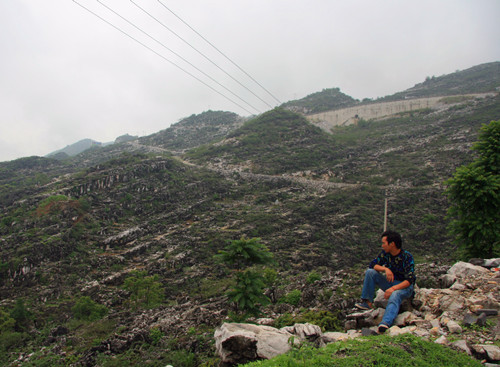Sichuan pepper revives Guizhou's poorest county
- By Zhang Rui
 0 Comment(s)
0 Comment(s) Print
Print E-mail China.org.cn, June 5, 2012
E-mail China.org.cn, June 5, 2012
In 2011, the average net annual income per capita in Dingtian was 4,800 yuan (US$753.8), with most households earning between 6,000 and 10,000 yuan a year just from pepper planting. With the extra income, they can afford private cars, trucks, motorbikes, refrigerators, TV sets, and washing machines, which they had never dreamed of having before.
Wang Fuchang moved back in 2000 after the persuasion of a village official, and with the income he made, he rebuilt his own home in 5 years and also bought a car. Now he earns about 50,000 yuan (US$7852.85) a year. Another 16 households who once moved out also moved back to get into the pepper farming trade, and many now earn a respectable living.
|
|
|
Desertification has affected the mountains around Dingtan, but Sichuan pepper farming has helped reclaim the local soil. [Zhang Rui / China.org.cn] |
The poverty-alleviation and economic development strategy, later called the "Dingtan Model", has been promoted in other villages by the central government.
In April 1999, then-Vice-Premier Wen Jiabao inspected the area and praised the model. "In this hostile environment, this is a brilliant miracle for men to create economic and ecological benefits in a land that people cannot even live on!" he said.
In 2003, the local government invested 1.29 million yuan into building a Sichuan pepper planting base. In 2005, Dingtan Sichuan Pepper Co. Ltd. was founded and now produces more than 1,000 tons of prickly-ash products a year, with an annual revenue of 18 million yuan (US$2.82 million). In 2007, 10 national ministries including the Ministry of Forestry honored Zhenfeng County as a "Home to Sichuan Pepper."
In the county, pepper farming has turned into a major industry with a total planted acreage of 100,000 mu (or 16,473 acres) and total production of 110,000 tons thus far, a production value of which reached 130 million yuan (US$20.41 million). In 2008, a TV series was made to recount the inspiring story of the Dingtan villagers.
Dingtan has also become a frequent subject of academic research. In 2003, Professor Xiong Kangning from Guizhou Normal School said, "If you talk about how the Chinese have dealt with stony desertification without mentioning the Dingtan Model, you don't know China."
In wider Zhengfeng County, desert plateaus make up over 585.47 square kilometers, 38.72 percent of the total land acreage. The local government has invested 95 million yuan (US$14.92 million) thus far into projects to fight rock desertification, 75.39 square kilometers were turned around and forest coverage was improved from 22.85 percent in 2007 to 29 percent in 2011. Studies have showed that the planting of Sichuan pepper can restore arability of 92 percent of desertified soil, and maintain soil and water resources at a rate of 94 percent.
Despite Dingtan's successes, there is still much to do in the future. Wang Fuchang told China.org.cn that the county still lacks water and roads. Without infrastructure improvements, the area can still be seriously affected by drought. Relevant government departments are currently working on infrastructure construction to compliment the poverty alleviation system already in place.







Go to Forum >>0 Comment(s)